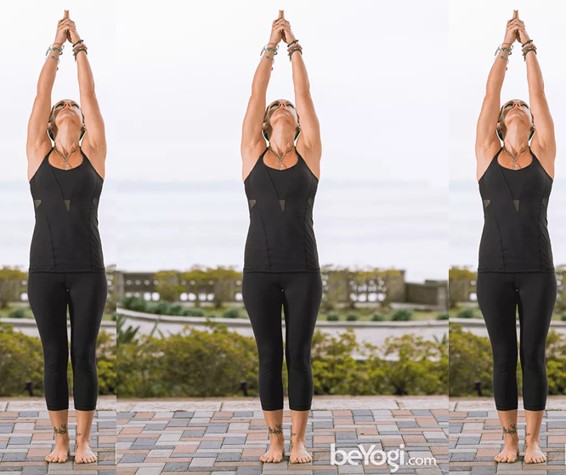
Practice Urdhva Hastasana Upward Salute Pose For Stress Free Day
Urdhva hastasana, upward salute pose is beginners yoga pose that yields multiple benefits for the body. It is one of the initial pose that we get into during Suryanamaskar or Sun salutation. It can be performed anytime or in the beginning of yoga practice. This pose helps to stretch the entire body and all the organs if done properly. Stretching and opening shoulder, aligning spinal cord, stretching abdominal muscles are possible through this simple pose. Stressed body and mind both feel relieved after practicing this very simple pose -Healthy Life
LEVEL :Beginner
Anatomy: Feet, Legs, Ribs, Shoulders, Spine
Pose Type: Standing
Sanskrit: Urdhva Hastasana (erd-vah ahs-TAHS-anna) urdhva = raised, elevated, tending upward
hasta = hand
BENEFITS
- Stretches the entire body
- Prepares the body for yoga practice
- Helps align the spinal column
- Opens the shoulders
- Improves digestion
- Relieves mild anxiety and fatigue
CONTRAINDICATIONS
- Shoulder or neck injuries (avoid lifting arms overhead)
HOW TO
- Stand in Tadasana (Mountain pose) with your feet together and arms at your sides. Ground down through your feet by pressing evenly into the big toe, little toe, and heel.
- As you inhale, sweep your arms out to the sides and then up toward the sky. Press your palms and fingers together, coming into prayer over your head.
- With an exhale, release your shoulders away from your ears to open the chest. Draw your front ribs in, toward your spine, and lengthen your tailbone toward the ground.
- Set your gaze up at your hands.
- Hold this pose for a few gentle breaths. To release, lower your hands (in prayer) to heart center. If performing a vinyasa flow, exhale and hinge forward at the hips, coming into Uttanasana (Standing Forward Fold).
MODIFY OR REPLACE
Alternatives:
- Lay on your mat and extend your arms overhead. Flex your feet and reach through the length of your body.
Modifications:
- If balance is a problem, separate the feet hip-distance apart.
SEQUENCING TIPS
Before:
- Tadasana (Mountain pose)
- Ardha Uttanasana (Standing Half Forward Bend)
After:
- Ardha Uttanasana
- Chaturanga (Four-Limbed Staff pose)
TEACHING CUES
- Ground down through all four corners of the feet.
- Keep your tailbone in a neutral position.
- Lower the shoulders away from the ears.
- Do not let the front ribs protrude forward—draw them down and in.
VARIATIONS
- Instead of joining the hands together, keep the arms extended shoulder-width apart overhead.
- Sweep the arms forward instead of out to the sides.
- With hands together, draw the arms back to create a slight backbend.
WATCH OUT FOR
- Shoulders up near the ears
- Internal rotation of the arms
- Hyperlordosis
- Ribs jutting forward
Image and article published here with prior permission from beyogi.com For more poses and teaching clues please visit beyogi.com
Author: HealthyLife | Posted on: November 10, 2022
« How Working On Being Happy Promotes Natural Antibodies Production Yoga for Diabetes Patients »






















Write a comment